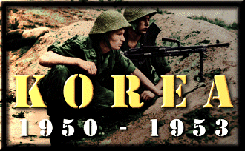Major K. Muir's VC
Major Kenneth Muir (50980)
The Argyll & Sutherland Highlanders (Princess Louise's)
(Posthumous)
London Gazette, 5th January, 1951.
On 23rd September, 1950, "B" and "C" Companies of the 1st Battalion The Argyll and Sutherland Highlanders attacked an enemy-held feature, Hill 282, and by 08:00hrs had consolidated upon it.
Some difficulty was experienced in evacuation the wounded from the position and demands were made for stretcher bearing parties to be send forward by the Battalion. At this juncture the position came under mortar and shell fire.
At approximately 09:00hrs small parties of the enemy started to infiltrate on the left flank, necessitating the reinforcing of the forward platoon. For the next hour this infiltration increased, as did the shelling and mortaring, causing further casualties within the two companies.

By 11:00hrs casualties were moderately severe and some difficulty was being experienced in holding the enemy. In addition, due to reinforcing the left flank and to providing personnel to assist with the wounded, both companies were so inextricably mixed that it was obvious that they must come under a unified command. Major Muir, although only visiting the position, automatically took over command and with complete disregard for his own personal safety started to move around the forward element, cheering on and encouraging the men to greater efforts despite the fact that ammunition was running low. He was continually under enemy fire, and , despite entreaties from officers and men alike, refuse to take cover.
An air-strike against the enemy was arranged and air recognition panels were put out on the ground. At approximately 12:15hrs the air strike came in, but unfortunately the aircraft hit the companies' position instead of that of the enemy. The main defensive position was hit with fire bombs and machine-gun fire, causing more casualties, and necessitating the withdrawal of the remaining troops to a position some fifty feet below the crest. There is no doubt that a complete retreat from the hill would have been fully justified at this time. Only some thirty fighting men remained and ammunition was extremely low. Major Muir, however, realized that the enemy had not taken immediate advantage of the unfortunate incident and that the crest was still unoccupied although under fire.
With the assistance of the three remaining officers, he immediately formed a small force of some thirty all ranks and personally led a counter-attack on the crest. To appreciate fully the implication of this, it is necessary to realize how demoralizing the effect of the air-strike had been and it was entirely due to the courage, determination and splendid example of this officer that such a counter-attack was possible. All ranks responded magnificently and the crest was retaken.
From this moment on, Major Muir's actions were beyond all possible praise. He was determined the wounded would had adequate time to be taken out and he was just as determined that the enemy would not take the crest. Grossly outnumbered and under heavy automatic fire, Major Muir moved about his small force, redistributing fast diminishing ammunition, and when the ammunition for his own weapon was spent he took over a 2-inch mortar, which he used with very great effect against the enemy. While firing the mortar he was still shouting encouragement's and advice to his men, and for a further five minutes the enemy were held. Finally, Major Muir was hit with two bursts of automatic fire which mortally wounded him, but even then he retained consciousness and was still determined to fight on. His last words were: "The Gooks will never drive the Argylls off this hill."
The effect of his splendid leadership on the men was nothing short of amazing and it was entirely due to his magnificent courage and example and the spirit which he imbued in those about him that all the wounded were evacuated from the hill, and, as was subsequently discovered, very heavy casualties inflicted on the enemy in defence of the crest. - London Gazette, 5th January, 1951.

Information provided by Ed Hansen



